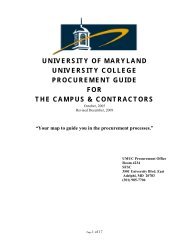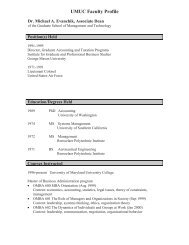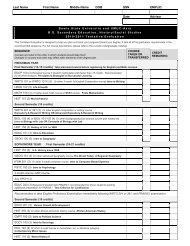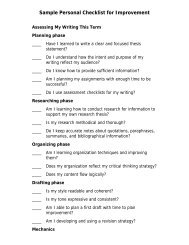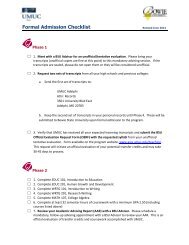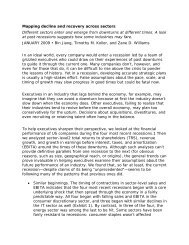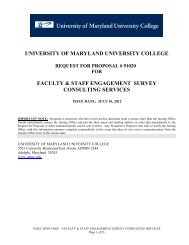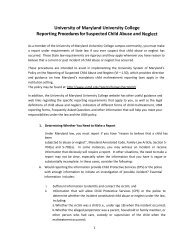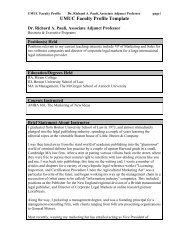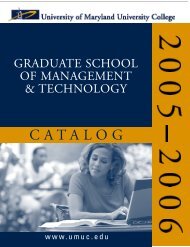1a. IntroSUS 2003 - University of Maryland University College
1a. IntroSUS 2003 - University of Maryland University College
1a. IntroSUS 2003 - University of Maryland University College
- No tags were found...
You also want an ePaper? Increase the reach of your titles
YUMPU automatically turns print PDFs into web optimized ePapers that Google loves.
HRMN 392 Stress Management inOrganizations (1)An exploration <strong>of</strong> the changing nature <strong>of</strong> work and stress inorganizations, due to a business emphasis on productivity andpersonal and family demands. Focus is on the causes <strong>of</strong> stressand methods <strong>of</strong> managing stress in organizational settings. Topicsinclude interactions, performance objectives, social structure,job characteristics, and other factors causing stress in organizations.Consideration is given to political climate, pressure to achieve, interpersonalconflict, and time pressures. Practical approaches toreduce stress at work are discussed. Students may receive creditfor only one <strong>of</strong> the following courses: BMGT 398Y, HRMN392, MGMT 398Y, or MGST 398H.HRMN 399 Independent Study in HumanResource Management (1–3)(Designed to allow students an opportunity to explore a humanresource management topic <strong>of</strong> special interest.) Prerequisites:HRMN 300 and departmental approval <strong>of</strong> a proposed topic.Independent research or project in human resource management,conducted under the supervision <strong>of</strong> a faculty member.HRMN 400 Human Resource Management:Analysis and Problems (3)Prerequisite: HRMN 300. A study <strong>of</strong> the role <strong>of</strong> human resourcemanagement in the strategic planning and operation <strong>of</strong> organizations,performance appraisal systems, and compensation and labor/management issues. The influence <strong>of</strong> federal regulations (includingequal opportunity, sexual harassment, discrimination, andother employee-related regulations) is analyzed. The critical evaluation<strong>of</strong> human resource problems is supported with a review <strong>of</strong>research findings, readings, discussions, case studies, and applicablefederal regulations. Students may receive credit for only one <strong>of</strong>the following courses: BMGT 460, HRMN 400, or TMGT 360.HRMN 404 Managing Diversity inOrganizations (3)Prerequisite: BMGT 364. An examination <strong>of</strong> the major forces intechnological and industrial change, with emphasis on workforcediversity. Topics include issues related to valuing and managingdiversity, problem solving, team building, customer service, strategicmanagement, organizational adaptability, and changing technologies,markets, and customers. Students may receive credit foronly one <strong>of</strong> the following courses: BMGT 498G, HRMN 404, orMGMT 498G.HRMN 406 Employee Training andDevelopment (3)Prerequisites: BMGT 364 and HRMN 300. An examination <strong>of</strong>employee training and human resource development in variousorganizations. Topics include the development, administration,and evaluation <strong>of</strong> training programs; employee development;career development; and organizational change. Issues in employeedevelopment (including assessment <strong>of</strong> employee competencies,opportunities for learning and growth, and the roles <strong>of</strong> managersin employee development) are explored. Students may receivecredit for only one <strong>of</strong> the following courses: BMGT 498I,HRMN 406, or MGMT 498I.HRMN 408 Employment Law forBusiness (3)(Fulfills the civic responsibility requirement.) A conceptual andfunctional analysis <strong>of</strong> the legal framework and principles <strong>of</strong> industrialand employment relations, with special emphasis on discriminationin the workplace. Topics include wrongful discharge; discriminationbased on race, sex, age, and disability; testing andperformance appraisal; labor/management issues; and employeebenefits. Salient global issues are also examined. Assignments mayinclude conducting relevant research using computer databasesand networks (such as LexisNexis and the Web) as well as othermethods for accessing information. Students may receive creditfor only one <strong>of</strong> the following courses: BMGT 468, BMGT 498G,HRMN 408, or MGMT 498G.HRMN 462 Labor Relations Law (3)A conceptual and functional analysis and application <strong>of</strong> legal principlesrelevant to labor/management relations and the collective bargainingprocess in both the domestic and global industrial and publicsectors. Topics include the historical and statutory development<strong>of</strong> the National Labor Relations Act and other related statutes; unionorganization and unfair labor practices; negotiation and administration<strong>of</strong> the collective bargaining agreement; economic pressures,including strikes, pickets, boycotts, and lockouts; arbitration andconflict resolution; public-sector regulation; and global labor/managementissues. Students may receive credit for only one <strong>of</strong> the followingcourses: BMGT 462 or HRMN 462.193




